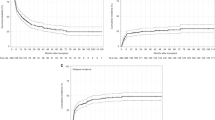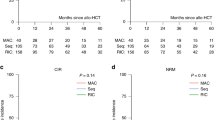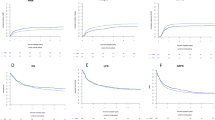Abstract
So far the impact of cytogenetics risk on outcome in the context of reduced intensity conditioning (RIC) allo-SCT has been poorly studied. We have identified 378 AML patients in first CR who underwent RIC allo-SCT from an HLA-matched sibling donor between 2000 and 2007 reported to the European Group for Bone and Marrow Transplantation and for whom detailed cytogenetics data were available (good risk: n=21; intermediate risk: n=304; and poor risk: n=53). With a median follow-up of 24 months (range: 1–93), 2-year non-relapse mortality, relapse rate (RR), leukemia-free survival (LFS) and OS were 14%, 31%, 55% and 61%, respectively. Cytogenetics was significantly associated with RR (good risk: 10%; intermediate risk: 28%; and poor risk: 55% at 2 years, P<0.0001) and LFS (good risk: 64%; intermediate risk: 57%; and poor risk: 38% at 2 years, P=0.003). In a multivariate analysis, RR and LFS were significantly higher and lower, respectively, in the high-risk cytogenetics group (P=0.001, P=0.004) and in patients with a higher WBC at diagnosis (>10 × 109/L) (P<0.001, P=0.004). As documented in the setting of myeloablative allo-SCT, patients with poor cytogenetics had increased RR and decreased LFS after RIC allo-SCT, requiring new prospective strategies to improve results in this subgroup.
This is a preview of subscription content, access via your institution
Access options
Subscribe to this journal
Receive 12 print issues and online access
$259.00 per year
only $21.58 per issue
Buy this article
- Purchase on Springer Link
- Instant access to full article PDF
Prices may be subject to local taxes which are calculated during checkout



Similar content being viewed by others
References
Lowenberg B, Downing JR, Burnett A . Acute myeloid leukemia. N Engl J Med 1999; 341: 1051–1062.
Döhner H, Estey EH, Amadori S, Appelbaum FR, Büchner T, Burnett AK et al. Diagnosis and management of acute myeloid leukemia in adults: recommendations from an international expert panel, on behalf of the European LeukemiaNet. Blood 2010; 115: 453–474.
Blaise D, Vey N, Faucher C, Mohty M . Current status of reduced intensity conditioning allogeneic stem cell transplantation for acute myeloid leukemia. Haematologica 2007; 92: 533–541.
Ringden O, Labopin M, Ehninger G, Niederwieser D, Olsson R, Basara N et al. Reduced intensity conditioning compared with myeloablative conditioning using unrelated donor transplants in patients with acute myeloid leukemia. J Clin Oncol 2009; 27: 4570–4577.
Gyurkocza B, Storb R, Storer BE, Chauncey TR, Lange T, Shizuru JA et al. Nonmyeloablative allogeneic hematopoietic cell transplantation in patients with acute myeloid leukemia. J Clin Oncol 2010; 28: 2859–2867.
Grimwade D, Hills RK, Moorman AV, Walker H, Chatters S, Goldstone AH et al. Refinement of cytogenetic classification in acute myeloid leukemia: determination of prognostic significance of rare recurring chromosomal abnormalities among 5876 younger adult patients treated in the United Kingdom Medical Research Council trials. Blood 2010; 116: 354–365.
Bacigalupo A, Ballen K, Rizzo D, Giralt S, Lazarus H, Ho V et al. Defining the intensity of conditioning regimens: Working definitions. Biol Blood Marrow Transplant 2009; 15: 1628–1633.
Glucksberg H, Storb R, Fefer A, Buckner CD, Neiman PE, Clift RA et al. Clinical manifestations of graft-versus-host disease in human recipients of marrow from HLA-matched sibling donors. Transplantation 1974; 18: 295–304.
Shulman H, Sullivan KM, Weiden PL, McDonald GB, Striker GE, Sale GE et al. Chronic graft-versus-host syndrome in man. A long-term clinicopathologic study of 20 Seattle patients. Am J Med 1980; 69: 204–217.
Gooley TA, Leisenring W, Crowley J, Storer BE . Estimation of failure probabilities in the presence of competing risks: new representations of old estimators. Stat Med 1999; 18: 695–706.
Burnett AK, Milligan D, Goldstone A, Prentice A, McMullin MF, Dennis M et al. The impact of dose escalation and resistance modulation in older patients with acute myeloid leukaemia and high-risk myelodysplastic syndrome: the results of the LRF AML14 trial. Br J Haematol 2009; 145: 318–332.
Pigneux A, Harousseau JL, Witz F, Sauvezie M, Bene MC, Luquet I et al. Addition of lomustine to idarubicin and cytarabine improves the outcome of elderly patients with de novo acute myeloid leukemia: a report from the GOELAMS. J Clin Oncol 2010; 28: 3028–3034.
Rölling C, Thiede C, Gramatzki M, Aulitzky W, Bodenstein H, Bornhaüser M et al. A novel prognostic model in elderly patients with acute myeloid leukemia-results of 909 patients entered into the prospective AML96 trial. Blood 2010; 116: 971–978.
Rowe JM, Tallman MS . How I treat acute myeloid leukemia. Blood 2010; 116: 3147–3156.
Yacoub-Agha I, Mesnil F, Kuentz M, Boiron JM, Ifrah N, Milpied N et al. Allogeneic marrow stem-cell transplantation from human leukocyte antigen-identical siblings versus human leukocyte antigen-allelic-matched unrelated donors (10/10) in patients with standard-risk hematologic malignancy: a prospective study from the French Society of Bone Marrow Transplantation and Cell Therapy. J Clin Oncol 2006; 24: 5695–5702.
Moore J, Nivison-Smith I, Goh K, Ma D, Bradstock K, Szer J et al. Equivalent survival for sibling and unrelated donor allogeneic stem cell transplantation for acute myelogeneous leukemia. Biol Blood Marrow Transplant 2007; 13: 601–607.
Lioure B, Delaunay J, Blaise D, Milpied N, Guardiola P, Cahn JY et al. Allogeneic stem cell transplantation (SCT) with non myeloablative conditioning regimen (NST) following intensive consolidation may be equivalent to conventional alloSCT and superior to autoSCT for patients over 50 with acute myeloid leukemia (AML) in first CR: first results of the AML 2001 trial. Blood (ASH annual meeting abstracts) 2006; 108: p99a, Abstract 319.
Aoudjhane M, Labopin M, Gorin NC, Shimoni A, Ruutu T, Kolb HJ et al. Comparative outcome of reduced intensity and myeloablative conditioning regimen in HLA identical sibling allogeneic haematopoietic stem cell transplantation for patients older than 50 years of age with acute myeloblastic leukaemia: a retrospective survey from the Acute Leukaemia Working Party (ALWP) of the European group for Blood and Marrow Transplantation (EBMT). Leukemia 2005; 19: 2304–2312.
Chevallier P, Szydlo RM, Blaise D, Tabrizi R, Michallet M, Uzunov M et al. Reduced-intensity conditioning before allogeneic hematopoietic stem cell transplantation in patients over 60 years: a report from the SFGM-TC. Biol Blood Marrow Transplant 2012; 18: 289–294.
Prebet T, Boissel N, Reutenauer S, Thomas X, Delaunay J, Cahn JY et al. Acute myeloid leukemia with translocation (8;21) or inversion (16) in elderly patients treated with conventional chemotherapy: a collaborative study of the French CBF-AML intergroup. J Clin Oncol 2009; 27: 4747–4753.
Kirschbaum MH, Stein AS, Popplewell L, Delioukina M, Chen R, Nakamura R et al. A phase I study in adults of Clofarabine combined with high-dose Melphalan as reduced-intensity conditioning for allogeneic transplantation. Biol Blood Marrow Transplant 2012; 18: 432–440.
McLarnon A, Piper KP, Goodyear OC, Arrazi JM, Mahendra P, Cook M et al. CD8(+) T-cell immunity against cancer-testis antigens develops following allogeneic stem cell transplantation and reveals a potential mechanism for the graft-versus-leukemia effect. Haematologica 2010; 95: 1572–1578.
Acknowledgements
We would like to thank all the participating EBMT centers and national registries, local and national data managers. We also thank Emmanuelle Polge and Benedicte Samey for their help in collecting data.
Author contributions: P Chevallier conceived and designed the study, analyzed data, recruited patients, provided clinical care, performed bibliographic search and wrote the manuscript. M Mohty, V Rocha recruited patients, provided clinical care, analyzed data and performed bibliographic search, helped with the statistical analyses and helped writing the manuscript. M Labopin performed data management, collection and statistical analyses. N Milpied, JJ Cornelissen, D Blaise, E Petersen, N Theorin, H Goker, G Socie and V Rocha recruited patients, provided clinical care and commented on the manuscript. All the above authors approved the manuscript for publication purposes.
Author information
Authors and Affiliations
Consortia
Corresponding author
Ethics declarations
Competing interests
The authors declare no conflict of interest.
Rights and permissions
About this article
Cite this article
Chevallier, P., Labopin, M., Milpied, N. et al. Impact of cytogenetics risk on outcome after reduced intensity conditioning allo-SCT from an HLA-identical sibling for patients with AML in first CR: a report from the acute leukemia working party of EBMT. Bone Marrow Transplant 47, 1442–1447 (2012). https://doi.org/10.1038/bmt.2012.55
Received:
Revised:
Accepted:
Published:
Issue Date:
DOI: https://doi.org/10.1038/bmt.2012.55
Keywords
This article is cited by
-
Cytogenetic abnormalities predict survival after allogeneic hematopoietic stem cell transplantation for pediatric acute myeloid leukemia: a PDWP/EBMT study
Bone Marrow Transplantation (2024)
-
Long-term results of reduced-intensity conditioning allogeneic hematopoietic cell transplantation for older patients with acute myeloid leukemia: a retrospective analysis of 10-year follow-up data
Bone Marrow Transplantation (2020)
-
Reduced-intensity conditioned allogeneic SCT in adults with AML
Bone Marrow Transplantation (2015)
-
Impact of in vivo T-cell depletion on outcome of AML patients in first CR given peripheral blood stem cells and reduced-intensity conditioning allo-SCT from a HLA-identical sibling donor: a report from the Acute Leukemia Working Party of the European group for Blood and Marrow Transplantation
Bone Marrow Transplantation (2014)
-
Comparison of conditioning regimens of various intensities for allogeneic hematopoietic SCT using HLA-identical sibling donors in AML and MDS with <10% BM blasts: a report from EBMT
Bone Marrow Transplantation (2013)



